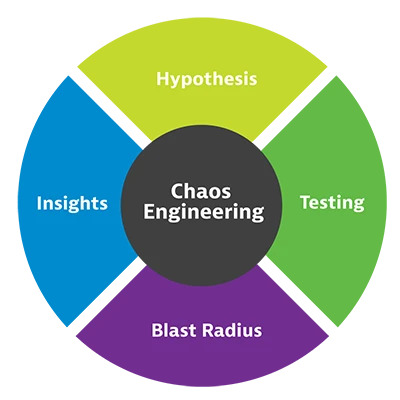
An Overview Of Chaos Engineering
What is Chaos Engineering?
Chaos Engineering is a technique used to assess the dependability of software systems by introducing controlled disorder into them. Organizations can leverage chaos engineering by establishing backup elements or procedures to ensure that the software functions smoothly during unexpected issues. The primary goal of chaos engineering is to identify vulnerabilities and weaknesses in an architectural system, enabling the entire team to evaluate performance in a production environment. Chaos engineering is derived from a concept called chaos theory and focuses on the immediate behavior of systems. It is straightforward to use, offers automation, and supports various configurations.
Definition of Chaos Engineering as per Wikipedia:
Chaos engineering is the discipline of experimenting on a system to build confidence in the system’s ability to withstand turbulent conditions in production.
According to Robert L. Devaney, to classify a dynamical system as chaotic, it must have these properties:
- It must be sensitive to initial conditions.
- It must be topologically transitive.
- It must have dense periodic orbits.

Image Credit: https://www.dynatrace.com/news/blog/what-is-chaos-engineering/
Principles of Chaos Engineering:
Automation: It helps ensure that experiments are repeatable and well-managed. Chaos engineers consider automation essential for conducting experiments regularly. Automation principles play an important role in chaos engineering, as it permits the repeatable, predictable, safe, and controlled injection of chaos into the system. Many chaos engineering tools, such as Chaos Toolkit and Chaos Monkey, are crucial for this purpose.
Monitoring and Observability: This principle is crucial as it collects data during chaos experiments and aids in assessing the impact of failures. These principles help organizations learn and improve the performance and reliability of their system. First, let’s discuss the monitoring principle, the process of analyzing and collecting data from a system in real-time to gain insights into its behavior, health, and performance. Monitoring plays an important role in chaos engineering as it allows for quick detection of experiment execution, among other things. Now, let’s discuss observability, a way to debug and understand a system by checking out its behavior and internal state, even when there is no clear monitoring.
Safety: Chaos engineering should be carried out with safety considerations in mind. In case of failure or catastrophic losses, chaos engineers have the capability to roll back any changes. Safety is one of the important principles of chaos engineering, required to manage experiments in a safe, controlled manner, so that the organization can identify weaknesses in their system, upgrade the overall system, and manage any losses and interference effectively.
Building a Hypothesis: Chaos engineers start by constructing hypotheses, which guide the chaos experiment. These hypotheses revolve around how a system should perform under adverse and typical conditions. When building a hypothesis for a chaos engineering experiment, it is important to define the goals, income, and variables to test. When introducing chaos, it is important to write a clear statement that narrates what you expect.
Controlled Experiments: Controlled chaos experiments involve introducing specific forms of chaos to measure various factors, such as server failures and network latency. It is a scientific investigation where researchers have to handle many variables to ensure that they carefully control many dependent variables. The main aim of the principle of controlled experiments is to establish the relationship between many variables and some irregular variables. In this principle of controlled experiments, researchers utilize a control group and other experimental groups to identify differences and draw correlations about the effect of manipulated variables.
Post-experiment Analysis: After a successful chaos experiment, the entire team’s task is to examine the data collected and determine how the system will react when subjected to injected failures. This is an important and challenging phase where you can assess deep learning and results from organized chaos experiments.
Benefits of Chaos Engineering:
Organizations derive several benefits from chaos engineering, including:
Enhanced User Experience: Chaos engineering ensures that users have the best experience, even when encountering errors, ultimately improving the overall system’s performance. Chaos engineering helps identify weaknesses in your system, resulting in less downtime, fewer outages, and an enhanced user experience. It also helps identify potential problems during deployments and software updates, which, when addressed by the team, enhances the user experience.
Cost Savings: System failures and outages can be expensive in terms of operational expenses, lost revenue, and customer churn. Chaos engineering helps mitigate these costs by decreasing financial losses stemming from customer dissatisfaction and lost revenue. It helps organizations optimize resources and identify under- or over-equipped resources, reducing irrelevant expenses.
Stimulates Innovation: Chaos engineering identifies structural flaws and designs improvements in software systems, fostering innovation. It supports the team in finding weaknesses and losses in the organization and helps uncover areas that need improvement and innovation to make the system more resilient and robust.
Cultural Shift: Chaos engineering promotes continuous learning, regular development, and experimentation between operations and development teams. The cultural shift emphasizes self-service, automation, and the reduction of manual mistakes, enabling faster and more valid testing. Chaos engineering serves as a vehicle for the team to share experiences, best practices, and knowledge, promoting a culture of knowledge sharing and continuous learning.
Improved Resilience: Chaos engineering identifies system weaknesses and enables teams to strengthen the system against unexpected issues.
Efficient Problem Detection: Chaos engineering helps identify and address problems quickly, reducing downtime. This helps organizations find and address problems that arise early, improve system resilience, and build a more robust and reliable system.
Conclusion: Chaos Engineering is a technique used to assess the dependability of software systems by introducing controlled disorder into them. The primary goal of chaos engineering is to identify vulnerabilities and weaknesses in an architectural system, enabling the entire team to evaluate performance in a production environment. In this blog article, you will be able to learn in-depth about the principles and benefits that occur through chaos engineering.


